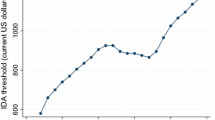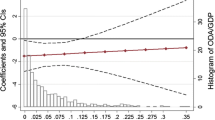Abstract
In this paper, the author focuses on the nonlinear nature of the aid to growth relationship to show that the “Big Push” hypothesis is consistent with capacity constraints in the understanding of aid effectiveness. The Big Push hypothesis proposes the existence of one threshold below which aid is not effective, whereas the constraints inferred by the concept of absorptive capacity suggest the existence of a second threshold above which aid is no longer effective. This paper addresses the issue of these thresholds which characterize the aid to growth relationship. Using a semi-parametric econometric method, the author finds that aid becomes effective only above a critical level, but what is more it becomes detrimental to growth at high aid flows. The author also investigates how the quality of institutions and economic vulnerability modify the level of these two thresholds. He finds that economic vulnerability is a key factor conditioning aid effectiveness.




Similar content being viewed by others
Notes
The same tests were conducted by specifying the following smoothing function \( f\left( {Aid, Polity} \right) \), interacting aid and the institutional quality index. Results (available upon request) confirm those provided in the “Appendix” using parametric methods. There is no evidence that institutional quality influences aid effectiveness.
References
Bellman, R. (1961). Adaptive control processes: A guided tour. Princeton: Princeton University Press.
Burnside, C., & Dollar, D. (2000). Aid, policies, and growth. American Economic Review, 90(4), 847–868.
Cariolle, J. (2011). The economic vulnerability index, 2010 update (FERDI Working Paper I09). Clermont-Ferrand: Fondation pour les études et recherches sur le développment international.
Chauvet, L., & Guillaumont, P. (2004). Aid and growth revisited: Policy, economic vulnerability and political instability. In B. Tungodden, N. Stern, & I. Kolstad (Eds.), Toward pro-poor policies—Aid, institutions and globalization. Washington, DC: World Bank/Oxford University Press.
Chauvet, L., & Guillaumont, P. (2009). Aid, volatility, and growth again: When aid volatility matters and when it does not. Review of Development Economics, 13(1), 452–463.
Chenery, H., & Strout, A. M. (1966). Foreign assistance and economic development. The American Economic Review, 56(4), 679–733.
Collier, P. (2006). Is aid oil? An analysis of whether Africa can absorb more aid. World Development, 34(9), 1482–1497.
Collier, P. and Dehn, J. (2001). Aid, shocks, and growth (Working Paper 2688). Washington, D.C.: The World Bank.
Collier, P., & Dollar, D. (2001). Can the world cut poverty in half? How policy reform and effective aid can meet international development goals. World Development, 29(11), 1787–1802.
Collier, P., & Dollar, D. (2002). Aid allocation and poverty reduction. European Economic Review, 45(1), 1–26.
Collier, P., & Goderis, B. (2009). Does aid mitigate external shocks? Review of Development Economics, 13(3), 429–451.
Dalgaard, C., & Hansen, H. (2001). On aid, growth and good policies. Journal of Development Studies, 37(6), 17–41.
Durbarry, R., Gemmell, N. and Greenaway, D. (1998). New evidence on the impact of foreign aid on economic growth (CREDIT Research Paper 98r8). Nottingham: University of Nottingham.
Easterly, W. (2006). The Big Push Déjà Vu: A review of Jeffrey Sachs’s the end of poverty: Economic possibilities for our time. Journal of Economic Literature, 44(1), 96–105.
Easterly, W., Levine, R., & Roodman, D. (2004). New data, new doubts: A comment on Burnside and Dollar’s “Aid, policies, and growth” (2000). American Economic Review, 94(2), 774–780.
Feeny, S., & de Silva, A. (2013). Measuring absorptive capacity constraints to foreign aid. Economic Modelling, 29(3), 725–733.
Feeny, S., & McGillivray, M. (2011). Scaling-up foreign aid: Will the ‘Big Push’ work? The World Economy, 34(1), 54–73.
Gomanee, K., Girma, S. and Morrisey, O. (2003). Searching for aid threshold effects (Credit Research Paper No. 03/15). Nottingham: University of Nottingham.
Guillaumont, P. (2011). The concept of structural economic vulnerability and its relevance for the identification of the least developed countries and other purposes (nature, measurement and evolution), document prepared for UN/DESA/CDP, CDP Background Paper no 12 (ST/ESA/2011/CDP/12).
Guillaumont, P., & Chauvet, L. (2001). Aid and performance: A reassessment. Journal of Development Studies, 37(6), 66–92.
Guillaumont, P., and Guillaumont Jeanneney, S. (2006), Efficacité, sélectivité et conditionnalité de l’aide. In Cohen D., Guillaumont Jeanneney S., Jacquet P. (Eds.) In La France et l’aide publique au développement, Conseil d’Analyse Economique, La Documentation Française, 2006.
Guillaumont, P., & Guillaumont Jeanneney, S. (2010). Big Push versus absorptive capacity: How to reconcile the two approaches, UNU-WIDER studies in development economics. In G. Mavrotas (Ed.), Foreign aid and development issues, challenges, and the New Agenda (pp. 297–322). Oxford: Oxford University Press.
Guillaumont, P. and Laajaj, R. (2006). When instability increases the effectiveness of aid projects (World Bank Policy Research Working Paper 4034). Washington, DC: World Bank.
Guillaumont, P. and Wagner, L. (2012). Aid and growth accelerations: vulnerability matters (WIDER Research Paper 2012/031). University of United Nations: World Institute of Development Economics Research.
Hadjimichael, M. T., Ghura, D., Muhleisen, M., Nord, R. and Ucer, E. M. (1995). Sub-Saharan Africa: growth, savings, and investment, 1986–93 (Occasional Paper 118). International Monetary Fund, Washington, DC.
Hansen, H., & Tarp, F. (2000). Aid effectiveness disputed. Journal of International Development, 12(3), 375–398.
Hansen, H., & Tarp, F. (2001). Aid and growth regressions. Journal of Development Economics, 64(2), 547–570.
Hastie, T. J., & Tibshirani, R. J. (1986). Generalized additive models. Statistical Science, 1(3), 297–318.
Hastie, T. J., & Tibshirani, R. J. (1990). Generalized additive models. New York: Chapman and Hall.
Heston A., Summers, R. and Aten, B. (2009), Penn world table version 6.3, Center for International Comparisons of Production, Income and Prices at the University of Pennsylvania, August 2009.
Lensink, R., & White, H. (2001). Are there negative returns to aid? Journal of Development Studies, 37(6), 42–65.
Marshall, M. G., and Jaggers, K. (2013). Polity IV project: Political regime characteristics and transitions 1800–2012. Dataset and codebook. http://www.systemicpeace.org/inscr/inscr.htm.
Millikan, M. F., & Rostow, W. W. (1957). A proposal: Key to an effective foreign policy. New York: Harpers and Brothers.
Rajan, R. G., & Subramanian, A. (2008). Aid and growth: What does the cross-country evidence really show? The Review of Economics and Statistics, 90(4), 643–665.
Roodman, D. (2007). The anarchy of numbers: Aid, development, and cross-country empirics. The World Bank Economic Review, 21(2), 255–277.
Rosenstein-Rodan, P. N. (1943). Problems of industrialization of eastern and south eastern Europe. The Economic Journal, 53(210/211), 202–211.
Sachs, J. (2005). The end of poverty. How we can make it happen in our lifetime. London: Penguin Book.
Sperlich, S. (2005). A note on nonparametric estimation with constructed variables and generated regressors (Working Paper). Universidad Carlos III.
Tavares, J. (2003). Does foreign aid corrupt? Economics Letters, 79(1), 99–106.
Wood, S. (2006). Generalized additive models: An introduction with R. Boca Raton: Chapman & Hall/CRC, Taylor & Francis Group.
Acknowledgments
This paper benefited from the financial support of the FERDI (Fondation pour les Etudes et Recherches sur le Développement International) and of the programme “Investissements d’Avenir” (reference ANR-10-LABX-14-01) of the French Government. The author thanks an anonymous referee for helpful comments and valuable discussions.
Author information
Authors and Affiliations
Corresponding author
Appendix
Appendix
See (Table 5).
About this article
Cite this article
Wagner, L. Identifying thresholds in aid effectiveness. Rev World Econ 150, 619–638 (2014). https://doi.org/10.1007/s10290-014-0187-4
Published:
Issue Date:
DOI: https://doi.org/10.1007/s10290-014-0187-4




